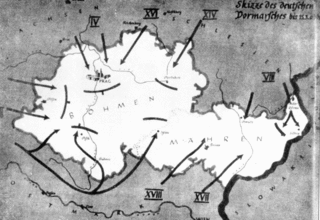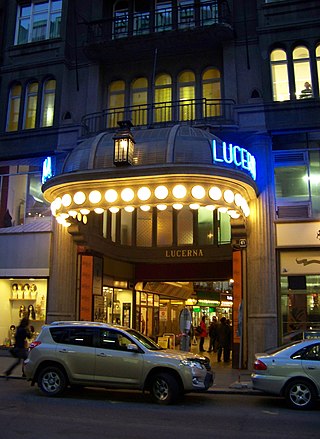
Czechoslovakia was a landlocked state in Central Europe, created in 1918, when it declared its independence from Austria-Hungary. In 1938, after the Munich Agreement, the Sudetenland became part of Nazi Germany, while the country lost further territories to Hungary and Poland. Between 1939 and 1945, the state ceased to exist, as Slovakia proclaimed its independence and the remaining territories in the east became part of Hungary, while in the remainder of the Czech Lands, the German Protectorate of Bohemia and Moravia was proclaimed. In 1939, after the outbreak of World War II, former Czechoslovak President Edvard Beneš formed a government-in-exile and sought recognition from the Allies.

Klement Gottwald was a Czech communist politician, who was the leader of the Communist Party of Czechoslovakia from 1929 until his death in 1953–titled as general secretary until 1945 and as chairman from 1945 to 1953. He was the first leader of Communist Czechoslovakia from 1948 to 1953.

The Prague Spring was a period of political liberalization and mass protest in the Czechoslovak Socialist Republic. It began on 5 January 1968, when reformist Alexander Dubček was elected First Secretary of the Communist Party of Czechoslovakia (KSČ), and continued until 21 August 1968, when the Soviet Union and most Warsaw Pact members invaded the country to suppress the reforms.

The Velvet Revolution or Gentle Revolution was a non-violent transition of power in what was then Czechoslovakia, occurring from 17 November to 28 November 1989. Popular demonstrations against the one-party government of the Communist Party of Czechoslovakia included students and older dissidents. The result was the end of 41 years of one-party rule in Czechoslovakia, and the subsequent dismantling of the command economy and conversion to a parliamentary republic.

A housing estate is a group of homes and other buildings built together as a single development. The exact form may vary from country to country.

The military occupation of Czechoslovakia by Nazi Germany began with the German annexation of the Sudetenland in 1938, continued with the creation of the Protectorate of Bohemia and Moravia, and by the end of 1944 extended to all parts of Czechoslovakia.

Ostrava is a city in the north-east of the Czech Republic, and the capital of the Moravian-Silesian Region. It has about 280,000 inhabitants. It lies 15 km (9 mi) from the border with Poland, at the confluences of four rivers: Oder, Opava, Ostravice and Lučina. Ostrava is the third largest city in the Czech Republic in terms of both population and area, the second largest city in the region of Moravia, and the largest city in the historical land of Czech Silesia. It straddles the border of the two historic provinces of Moravia and Silesia. The wider conurbation – which also includes the towns of Bohumín, Havířov, Karviná, Orlová, Petřvald and Rychvald – is home to about 500,000 people, making it the largest urban area in the Czech Republic apart from the capital Prague.
Panelák is a colloquial term in Czech and Slovak for a large panel system panel building constructed of pre-fabricated, pre-stressed concrete, such as those extant in the former Czechoslovakia and elsewhere in the world. Paneláks are usually located in housing estates.

The Czechoslovak Socialist Republic, known from 1948 to 1960 as the Czechoslovak Republic or Fourth Czechoslovak Republic, was the Czechoslovak state from 1948 until 1989, when the country was under communist rule, and was regarded as a satellite state in the Soviet sphere of interest.
State Security or StB / ŠtB, was the secret police force in communist Czechoslovakia from 1945 to its dissolution in 1990. Serving as an intelligence and counter-intelligence agency, it dealt with any activity that was considered opposition to the Communist Party of Czechoslovakia and the state.

Avenida Presidente Masaryk is a thoroughfare in the affluent Polanco neighborhood of Mexico City. It stretches from Calzada General Mariano Escobedo in the east to Avenida Ferrocarril de Cuernavaca in the west, passing along the north side of the Polanquito restaurant district that borders Parque Lincoln. Masaryk is one of the most expensive shopping districts in the world and competes with Avenida Madero in the Historic Center for the title of street with the highest rents in the city.

Systematization in Romania was a program of urban planning carried out by the Romanian Communist Party under the leadership of Nicolae Ceaușescu. Ceaușescu was impressed by the ideological mobilization and mass adulation of North Korea under its Juche ideology during his East Asia visit in 1971, and issued the July Theses shortly afterwards.

The Polish minority in the Czech Republic is a Polish national minority living mainly in the Trans-Olza region of western Cieszyn Silesia. The Polish community is the only national minority in the Czech Republic that is linked to a specific geographical area. Trans-Olza is located in the north-eastern part of the country. It comprises Karviná District and the eastern part of Frýdek-Místek District. Many Poles living in other regions of the Czech Republic have roots in Trans-Olza as well.

The expulsion of Germans from Czechoslovakia after World War II was part of a series of evacuations and deportations of Germans from Central and Eastern Europe during and after World War II.

The Republic of Poland and Czechoslovakia established relations early in the interwar period, after both countries gained independence. Those relations were somewhat strained by the Polish–Czechoslovak border conflicts over Trans-Olza and Cieszyn in the early 1920s and late 1930s. Both countries joined the Allies during World War II. After the war they both fell into the Soviet sphere of influence. Poland, together with other Eastern Bloc countries, participated in the Warsaw Pact invasion of Czechoslovakia in 1968. Relations between the two countries were nonetheless rather amicable, but became somewhat strained in the aftermath of the rise of the Solidarity movement in Poland in 1980 and 1981, improving again afterwards.
After World War I, the Romani people in Czechoslovakia formed an ethnic community, living on the social periphery of the mainstream Czechoslovakian population.

Lucerna Music Bar is a concert club in Prague, Czech Republic. It is housed within Lucerna Palace.
Milan Pitlach was a Czech architect and photographer.

Sídlisko is a term used in Slovak which mainly means housing estate. Other terms associated with this term are housing project, housing estate, settlement, or neighbourhood. In these housing projects, apartment buildings are built in the most of the sídlisko's area, most of these building being paneláks. Most paneláks were built by the socialist government of the former Czechoslovakia. Such buildings remain in these housing projects and many of them are being gentrified and painted vibrant colors today. These housing projects can be found in urban areas, as well as in suburbs. These housing projects were built to provide fast and affordable housing. Most of these housing projects are occupied by various different social classes. People living in these housing projects usually own their apartments, but some owners rent them instead, usually as private landlords, a legal concept similar to Section 8.
Slovak National Uprising Square is a public square in Ostrava, Czech Republic. The square is located in Ostrava-Jih, the most populous district of the Moravian-Silesian metropole. Developed over the course of the 1950s, it is currently named after one of the most important historical events in Slovak history, the Slovak National Uprising (Czech: Slovenské národní povstání, Slovak: Slovenské národné povstanie).


















